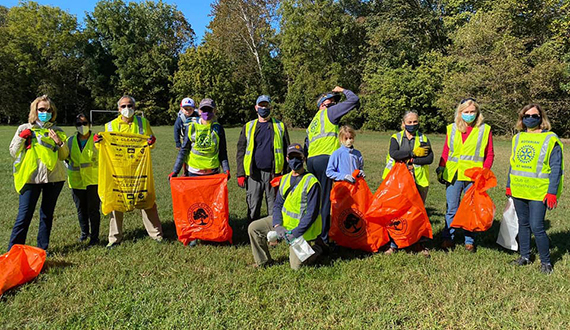
Members of the Metro Bethesda Rotary Club enjoy a service project.
By Barton Goldenberg, member of the Metro Bethesda Rotary Club, Maryland, USA
I had the pleasure to be invited recently to an online Rotary discussion regarding member apathy. We were two past district governors, an assistant governor, two past club presidents – one from a large club and one from a smaller club— and a community service chair from a large club.
The topic was why some (many?) Rotarians are reluctant to participate or get involved in Rotary activities. Based on a district-wide survey of the impacts of the COVID-19 pandemic I facilitated in June at the end of my governor year (results are posted on our district website), we knew we would be facing membership challenges this Rotary year, particularly around member engagement.
Many clubs are honorably focusing on member acquisition by pro-actively reaching out to all parts of their local community. These clubs realize diversity is critical for long-term club health and engagement. Many of these clubs also have created a welcome process to ensure prospective members have a great experience when visiting a club or participating in a service project.
Other clubs are focusing more on retention. Did you know Rotary lost as many members last year as they gained? All the effort we put into gaining new members exits out the back door when they leave Rotary. If your club is not focusing on retention you may be headed for trouble. To determine how best to keep members, consider the following reasons why Rotarians stick with Rotary year-after-year:
- Fellowship: Many members, particularly older members, belong to Rotary for fellowship. But fellowship alone is unlikely to keep members engaged and provide individual growth. Relying solely on fellowship for member engagement can be risky since some members will leave Rotary and others die. The solution is to continually extend fellowship opportunities, like having older members mentor younger members, encouraging members to participate in district conferences, or inviting them to attend the Rotary International Convention where they can make new connections.
- Fundraising: Other members enjoy making donations to the club and/or The Rotary Foundation as their expression of member engagement. While giving is very important, a member may not be able to give every year, especially during this pandemic. It’s important to give them a reason to be excited beyond their ability to give, and to share how funds are being spent so they can be excited whether or not they can contribute.
- Service Projects: These are a very effective way at getting members engaged. I belong to a club of 74 members. It was small not too long ago, which is why I believe small clubs can learn a lot from how larger clubs organize and manage service projects. We have at least 10-15 service projects going on at any one point in time, with 5-25 members participating in each project. If a project does not catch on, we drop it. If a lot of people are interested, we commit additional resources. One of the more important questions you will want to ask is: “Is my club offering the right service projects to our members, and what is the best way to determine this?” Nothing is more effective than regularly surveying your members.
- Networking: Many join Rotary because of networking opportunities. To keep them, though, you will need to expand their networking opportunities beyond your club. Provide chances for them to participate in collaborative fundraising projects with other clubs and external organizations, or to participate in collaborations you have created between your club and the local Chamber of Commerce, Toastmasters, or other partner organizations.
Many clubs also are increasingly focusing on the importance of continual member growth to drive long-term member engagement. During my governor year, I identified outstanding Rotarians that were being underused by their club and/or district, and as a result were getting apathetic. I offered them new positions in the district such as assistant governor or district committee chair positions. As a result, their apathy disappeared and they displayed a renewed Rotary spirit.
In the private sector, we often create an individual growth plan for every employee to ensure satisfaction, loyalty, and long-term commitment. It makes sense to do the same for each member in your club. For example, which members have you identified as an emerging leader and invited to attend Zone Emerging Leader events? Which members have you invited to attend Rotary Leadership Institute courses? Which members have you identified to mentor Rotaractors?
I encourage every club to focus on acquisition, retention, and growth. Once your club has this basic framework in place, you are ready to use it to determine appropriate next steps that will keep each member actively engaged. You can accomplish this by creating ‘member journeys,’ which describe the sequence of steps happy members have taken along their Rotary journey. Remember, members may join Rotary for one reason but over time learn to love Rotary for many reasons. Creating member journeys are particularly relevant to secure member engagement.
About the author: Barton Goldenberg is past governor of District 7620, and a member of the Metro Bethesda Rotary Club. He has spent the past 35 years created and implementing customer strategy for global, best-in-class organizations. Contact Barton at barton7620dg2019@gmail.com
https://blog.rotary.org/2020/12/18/3-ingredients-to-keep-members-happy/
